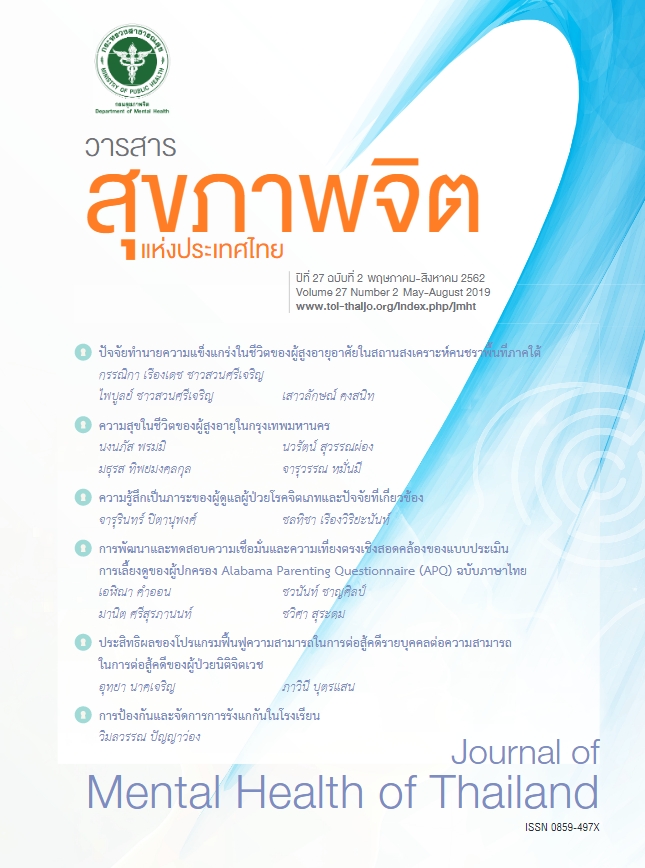การป้องกันและจัดการการรังแกกันในโรงเรียน
คำสำคัญ:
การรังแกกัน, การรังแกกันในโรงเรียน, การป้องกันการรังแกกันบทคัดย่อ
วัตถุประสงค์: เพื่อทบทวนวรรณกรรมที่เกี่ยวข้องกับการป้องกันและจัดการการรังแกกันในโรงเรียน
วิธีการ: สืบค้นงานวรรณกรรมและงานวิจัยจากฐานข้อมูลอิเล็กทรอนิกส์ โดยเน้นงานวิจัยประเภทการทบทวนวรรณกรรมอย่างเป็นระบบที่เกี่ยวข้องกับการป้องกันและจัดการการรังแกกันในโรงเรียน กิจกรรมและแนวทางในระดับชาติ
ผล: การป้องกันการรังแกกันในโรงเรียนที่มีประสิทธิภาพ ควรทำแบบทั้งโรงเรียน (whole-school approach) และเสริมสร้างวัฒนธรรมความปลอดภัย ครูและบุคลากรในโรงเรียนมีบทบาทสำคัญและควรได้รับการพัฒนาความรู้และทักษะในการสร้างวัฒนธรรมดีและจัดการการรังแกกันที่เหมาะสม การจัดกิจกรรมสำหรับนักเรียน ควรจัดเพื่อนักเรียนทุกคน และผนวกเนื้อหาเข้าไปในหลักสูตรการเรียนปกติ จะได้ผลดีและยั่งยืนกว่าการเจาะจงเฉพาะกลุ่มและกิจกรรมระยะสั้น โดยเนื้อหาควรเน้นทักษะทางอารมณ์สังคม พฤติกรรมดี และการจัดการการรังแกกันที่เหมาะสม มุ่งเน้นที่เด็กนักเรียนผู้เห็นเหตุการณ์เป็นผู้รายงานเหตุการณ์และช่วยเหลือขัดขวางการรังแกกัน
สรุป: การป้องกันและจัดการการรังแกกันในโรงเรียนต้องเป็นการเปลี่ยนแปลงในเชิงวัฒนธรรมและสิ่งแวดล้อมในโรงเรียน ซึ่งต้องอาศัยการเปลี่ยนแปลงตั้งแต่ระดับนโยบายจนถึงทุกคนในโรงเรียน และให้เวลาในการดำเนินการในระยะยาวและต่อเนื่อง จึงจะมีประสิทธิผลที่ชัดเจนและยั่งยืน
Downloads
References
2. Evans CBR, Fraser MW, Cotter KL. The effectiveness of school-based bullying prevention programs: a systematic review. Aggression and Violent Behavior. 2014;19:532–44. Doi:10.1016/j.avb.2014.07.004.
3. World Health Organization (WHO). Mental health status of adolescents in south-east Asia: evidence for action [Internet]. New Delhi: World Health Organization, Regional Office for South-East Asia; 2017. [cited 2018 Apr 24]. Available from: https://apps.who.int/iris/handle/10665/254982
4. ศุภรัตน์ เอกอัศวิน และจอมสุรางค์ โพธิ์สัตย์. ความชุกของประสบการณ์รังแกและโรคร่วมจิตเวชในนักเรียนไทย [Prevalence of bullying experiences and psychiatric disorders in Thai students]. วารสารสุขภาพจิตแห่งประเทศไทย. 2561;25:96-106. Thai.
5. Sittichai R, Smith PK. Bullying and cyberbullying in Thailand: coping strategies and relation to age, gender, religion and victim status. Journal of New Approaches in Educational Research. 2018;7:24-30. Doi:10.7821/naer.2018.1.254.
6. Radliff KM, Wang C, Swearer SM. Bullying and peer victimization: an examination of cognitive and psychosocial constructs. Journal of Interpersonal Violence. 2016;31:1983-2005. Doi:10.1177/0886260515572476.
7. Kaltiala-Heino R, Rimpelä M, Marttunen M, Rimpelä A, Rantanen P. Bullying, depression, and suicidal ideation in Finnish adolescents: school survey. BMJ. 1999;319:348-51.
8. Ttofi MM, Farrington DP. Effectiveness of school-based programs to reduce bullying: a systematic and meta-analytic review. Journal of Experimental Criminology. 2011;7:27-56. Doi:10.1007/s11292-010-9109-1.
9. Ttofi MM, Farrington DP. Risk and protective factors, longitudinal research, and bullying prevention. New directions for youth development. 2012;133:85-98.
10. Childnet International, Department of Education, UK. Cyberbullying: understand, prevent and response – guidance for school [Internet]. London: Childnet international; 2016. [cited 2017 Dec 26]. Available from: https://www.childnet.com/ufiles/Cyberbullying-guidance2.pdf
11. Pepler DJ, Craig W. Making a different in bullying [Internet]. [cited 2018 Apr 4]. Available from: https://peacefulschoolsinternational.org/wp-content/uploads/making_a_difference_in_bullying.pdf
12. Milsom A, Gallo LL. Bullying in middle schools: prevention and intervention. Middle School Journal. 2006: 12-19.
13. UNESCO. Review of Homophobic bullying in educational institutions [Internet]. UNESCO: Paris; 2012. [cited 2017 December 26]. Available from: https://unesdoc.unesco.org/images/0021/002157/215708e.pdf
14. มหาวิทยาลัยมหิดล องค์กรแพลนประเทศไทย และยูเนสโก ประเทศไทย. การรังแกต่อกลุ่มนักเรียนที่เป็นหรือถูกมองว่าเป็นคนข้ามเพศ หรือคนรักเพศเดียวกัน ในโรงเรียนระดับมัธยมศึกษา: รูปแบบ ความชุก ผลกระทบ แรงจูงใจ และมาตรการการป้องกันใน 5 จังหวัดของประเทศไทย [Bullying targeting students who are or are perceived to be same-sex attracted of transgender, attending general secondary school: nature, prevalence, impact, motivation, and existing prevention in 5 provinces of Thailand] [อินเตอร์เน็ต]. กรุงเทพมหานคร: มหาวิทยาลัยมหิดล; 2557 [สืบค้นเมื่อวันที่ 9 ตค. 2561]. จาก: https://unesdoc.unesco.org/images/0022/002275/227518tha.pdf Thai.
15. Pepler D, Craig W. Bullying prevention and intervention in the school environment: factsheets and tools [Internet]. Ontario: Prevnet; 2014. [cited 2017 Dec 26]. Available from: https://www.prevnet.ca/sites/prevnet.ca/files/prevnet_facts_and_tools_for_schools.pdf
16. Barbero JAJ, Hernández JAR, Esteban BL, García MP. Effectiveness of antibullying school programmes: A systematic review by evidence levels. Children and Youth Services Review 2012;34:1646–58. Doi:10.1016/j.childyouth.2012.04.025
17. Farrington DP, Ttofi MM. School-based programs to reduce bullying and victimization. Campbell Systematic Reviews 2009 [Internet]. [cited 2018 Jan 9]. Avalable from https://www.campbellcollaboration.org/library/school-based-programmes-to-reduce-bullying-victimisation.html
18. Olweus D. Bullying at school: basic facts and effective intervention programme. Promotion & Education. 1994;1:27-31.
19. Olweus D, Limber S. Bullying in school: Evaluation and dissemination of the Olweus Bullying Prevention Program. Am J Orthopsychiatry. 2010;80:124-34.
20. Fox BH, Farrington DP, Ttofi MM. Successful bullying prevention programs: influence of research design, implementation features, and program components. Journal of Conflict and Violence. 2012;6:273–83.
21. Downes P, Cefai C. How to prevent and tackle bullying and school violence: evidence and practices for strategies for inclusive and safe schools [Internet]. Luxembourg: Publications Office of the European Union; 2016. [cited 2017 Dec 26]. Available from: https://nesetweb.eu/NESET-II_Bullying-Report.pdf
22. Taylor RD, Oberle E, Durlak JA, Weissberg RP. Promoting positive youth development through school-based social and emotional learning interventions: a meta-analysis of follow-up effects. Child Dev. 2017;88:1156-71. Doi:10.1111/cdev.12864.
23. Fonagy P, Twemlow SW, Vernberg EM, Nelson MJ, Dill EJ, Little TD et al. A cluster randomized controlled trial of child-focused psychiatric consultation and a school systems-focused intervention to reduce aggression. The Journal of Child Psychology and Psychiatry. 2009;50:607-16.
24. Weissberg RP, Durlak JA, Domitrovich CE, Gullotta TP. Social and emotional learning: Past, present, and future. In Durlak JA, Domitrovich CE, Weissberg RP, Gullotta TP, editor. Handbook of social and emotional learning: Research and practice. New York: Guilford; 2015. p.3–19.
25. Kärnä A, Voeten M, Little T, Poskiparta E, Kaljonen A, Salmivalli C. A large-scale evaluation of the KiVa antibullying program: grades 4-6. Child Dev. 2011;82:311-30.
26. Salmivalli C, Poskiparta E, Ahtola A, Haataja A. The implementation and effectiveness of the KiVa antibullying program in Finland. European Psychologist. 2013;18:79-88.
27. Evans CBR, Smokowski PR. Prosocial bystander behavior in bullying dynamics: assessing the impact of social capital. Journal of youth and adolescence. 2015;44:2289–307. doi:10.1007/s10964-015-0338-5.
28. Barbero JAJ, Hernández JAR, Zaragoza LL, García MP, Esteban BL. Effectiveness of anti-bullying school programs: A meta-analysis. Children and Youth Services Review. 2016;61:165–75. doi:10.1016/j.childyouth.2015.12.015.
29. Brunecz SL. More harm than good? Why schools who take a zero-tolerance stance on cyberbullying cause more problems than solutions? Journal of Law,Technology & the Internet. 2015;6:13-42.
30. U.S. Department of Health and Human Services. Misdirections in Bullying Prevention and Intervention [Internet]. [cited 2017 Dec 26]. Available from: https://www.stopbullying.gov/sites/default/files/2017-10/misdirections-in-prevention.pdf
31. สมบัติ ตาปัญญา. รายงานผลการศึกษาฉบับสมบูรณ์ โครงการวิจัย การศึกษาเพื่อพัฒนารูปแบบแนวทางการป้องกันความรุนแรงต่อเด็กแบบยั่งยืน ปีที่ 2 [The development of sustainable bullying prevention in children, 2nd year] [อินเตอร์เน็ต]. [สืบค้นเมื่อวันที่ 6 เมษายน 2561]. จาก: https://resource.thaihealth.or.th/library/12064 Thai.
32. Lanigan AR. A systematic review of bullying prevention programs in schools [Master Dissertation]. Minnesota: St. Catherine University; 2015.
33. Nosworthy N, Rinaldi C. A review of school board cyberbullying policies in Alberta. The Alberta Journal of Educational Research. 2013;58:509-25.
34. Buijs GJ. Better Schools through Health: networking for health promoting schools in Europe. European Journal of Education. 2009;44:507-20.
35. UNESCO. School violence and bullying: global status 2017 [Internet]. [cited 2018 Oct 12]. Available from: https://unesdoc.unesco.org/images/0024/002469/246970e.pdf
Downloads
เผยแพร่แล้ว
How to Cite
ฉบับ
บท
License
- ผู้อ่านสามารถนำข้อความ ข้อมูล จากวารสารไปใช้ไปใช้ประโยชน์ทางวิชาการได้ เช่น เพื่อการสอน เพื่อการอ้างอิง แต่การนำไปใช้เพื่อวัตถุประสงค์อื่น เช่น เพื่อการค้า จะต้องได้รับอนุญาตเป็นลายลักษณ์อักษรจากกรมสุขภาพจิตก่อน
- ความคิดเห็น ข้อมูล และบทสรุปต่าง ๆ ที่ลงตีพิมพ์ในวารสารสุขภาพจิตแห่งประเทศไทยเป็นของผู้เขียนบทความและมิได้แสดงว่ากองบรรณาธิการหรือกรมสุขภาพจิตเห็นพ้องด้วย



